How HRM/CPM Contributes to Human Happiness in Organizations
VerifiedAdded on 2021/01/02
|7
|2052
|79
Essay
AI Summary
This essay delves into the relationship between Human Resource Management (HRM) and Contemporary People Management (CPM) and their contributions to achieving the ethical goal of human happiness within organizations. It explores how strategic HRM, including motivational theories, can foster a sense of belonging and increase productivity, ultimately leading to employee happiness. The assignment examines various HRM methods employed in different organizational settings, such as recruitment, training, performance management, and employee relations, highlighting their impact on employee well-being. It also discusses the development of analytical and communication skills, crucial for employee and management participation, and how CPM can assess and refine these skills to achieve ethical goals. The essay acknowledges the challenges in implementing effective HRM due to differing opinions and preferences between management and employees, emphasizing the importance of aligning organizational objectives with employee needs to promote a positive and productive work environment.
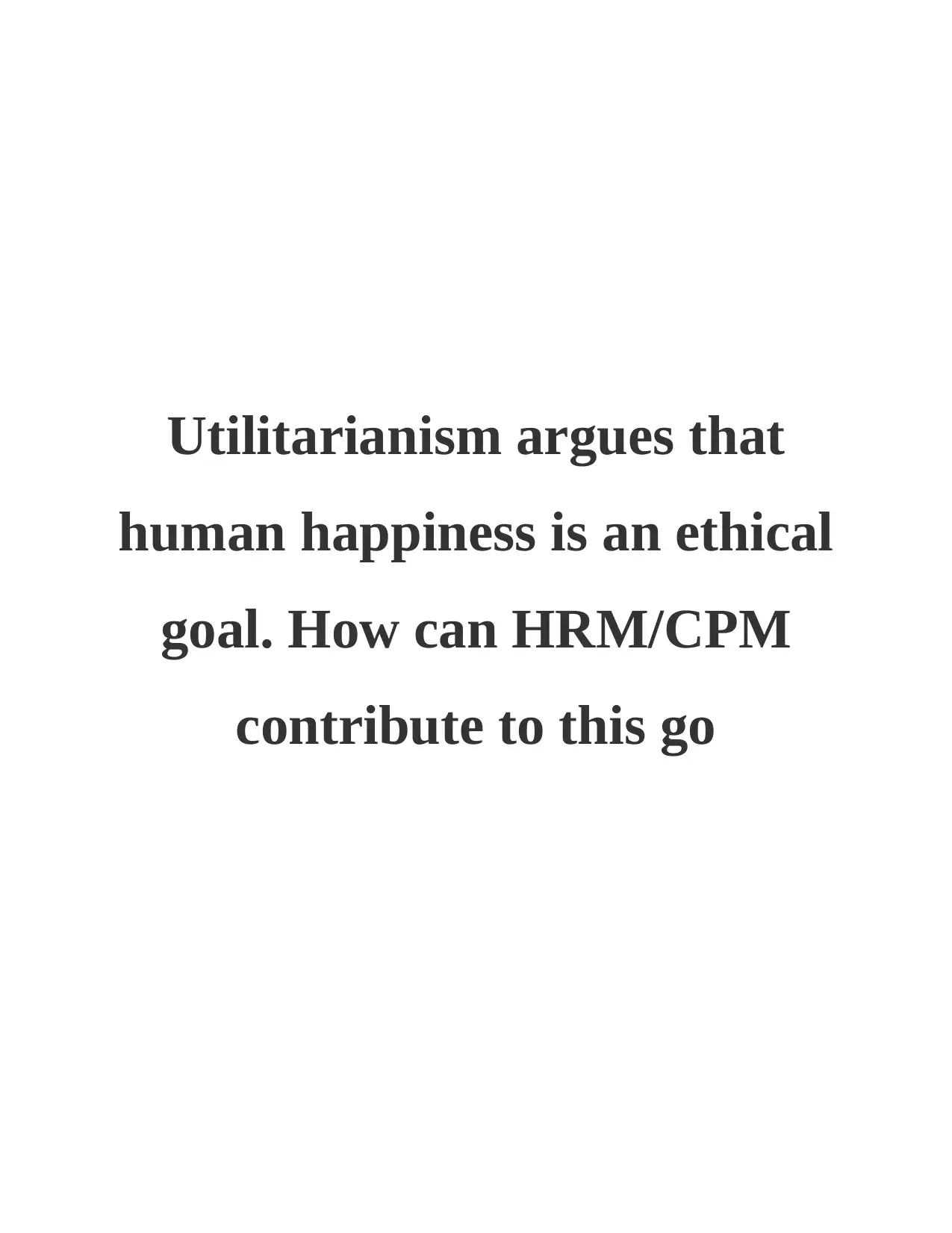
Utilitarianism argues that
human happiness is an ethical
goal. How can HRM/CPM
contribute to this go
human happiness is an ethical
goal. How can HRM/CPM
contribute to this go
Paraphrase This Document
Need a fresh take? Get an instant paraphrase of this document with our AI Paraphraser
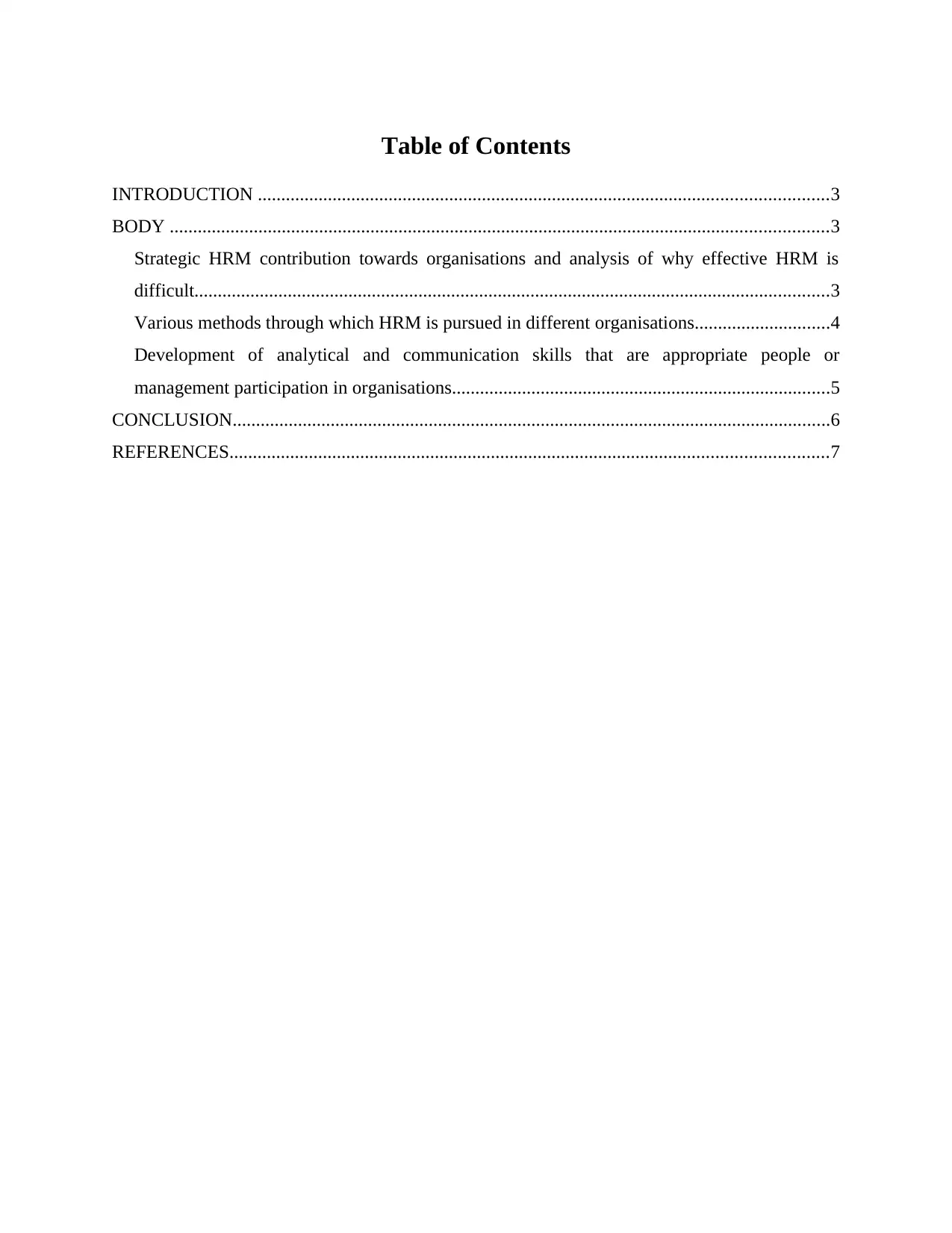
Table of Contents
INTRODUCTION ..........................................................................................................................3
BODY .............................................................................................................................................3
Strategic HRM contribution towards organisations and analysis of why effective HRM is
difficult........................................................................................................................................3
Various methods through which HRM is pursued in different organisations.............................4
Development of analytical and communication skills that are appropriate people or
management participation in organisations.................................................................................5
CONCLUSION................................................................................................................................6
REFERENCES................................................................................................................................7
INTRODUCTION ..........................................................................................................................3
BODY .............................................................................................................................................3
Strategic HRM contribution towards organisations and analysis of why effective HRM is
difficult........................................................................................................................................3
Various methods through which HRM is pursued in different organisations.............................4
Development of analytical and communication skills that are appropriate people or
management participation in organisations.................................................................................5
CONCLUSION................................................................................................................................6
REFERENCES................................................................................................................................7
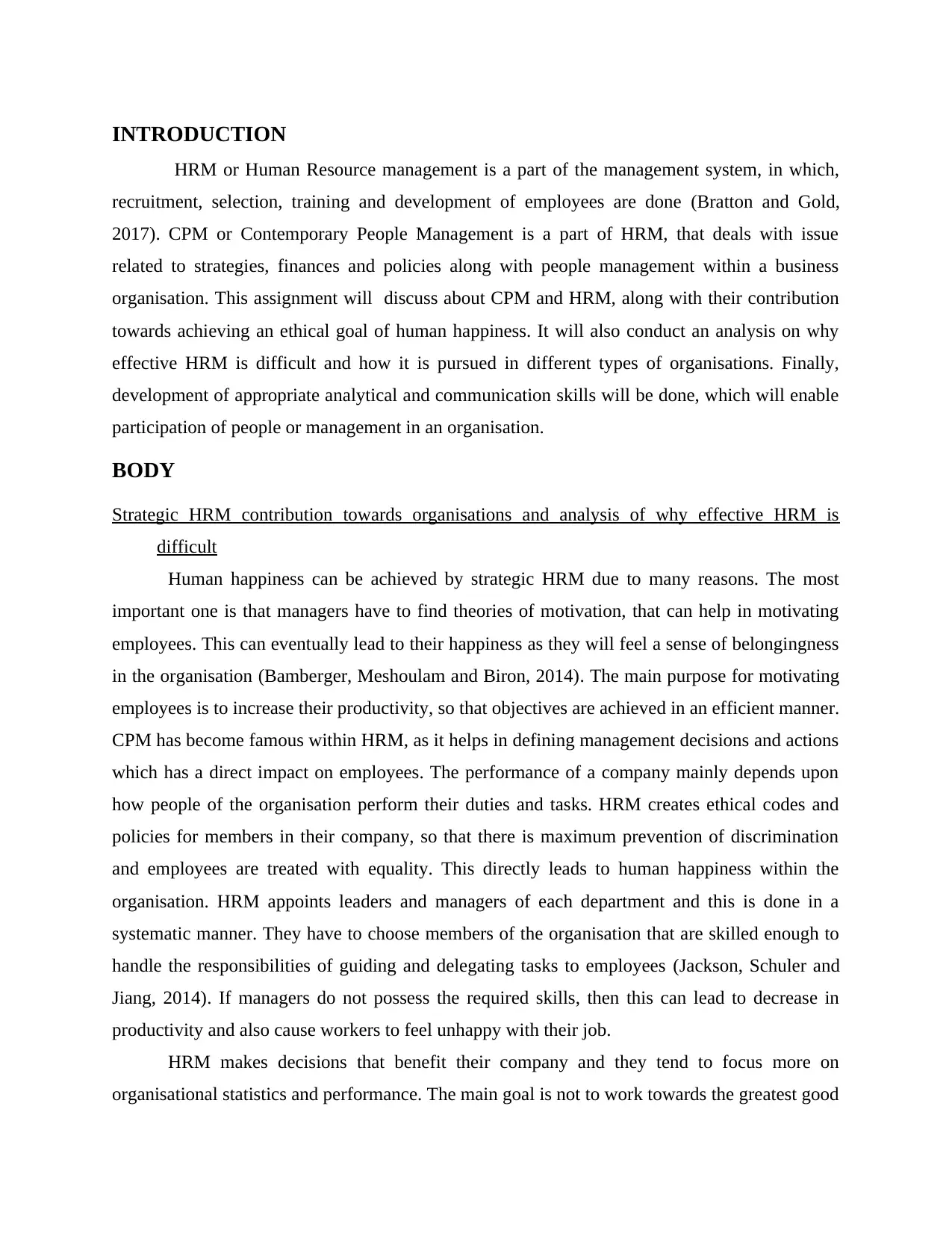
INTRODUCTION
HRM or Human Resource management is a part of the management system, in which,
recruitment, selection, training and development of employees are done (Bratton and Gold,
2017). CPM or Contemporary People Management is a part of HRM, that deals with issue
related to strategies, finances and policies along with people management within a business
organisation. This assignment will discuss about CPM and HRM, along with their contribution
towards achieving an ethical goal of human happiness. It will also conduct an analysis on why
effective HRM is difficult and how it is pursued in different types of organisations. Finally,
development of appropriate analytical and communication skills will be done, which will enable
participation of people or management in an organisation.
BODY
Strategic HRM contribution towards organisations and analysis of why effective HRM is
difficult
Human happiness can be achieved by strategic HRM due to many reasons. The most
important one is that managers have to find theories of motivation, that can help in motivating
employees. This can eventually lead to their happiness as they will feel a sense of belongingness
in the organisation (Bamberger, Meshoulam and Biron, 2014). The main purpose for motivating
employees is to increase their productivity, so that objectives are achieved in an efficient manner.
CPM has become famous within HRM, as it helps in defining management decisions and actions
which has a direct impact on employees. The performance of a company mainly depends upon
how people of the organisation perform their duties and tasks. HRM creates ethical codes and
policies for members in their company, so that there is maximum prevention of discrimination
and employees are treated with equality. This directly leads to human happiness within the
organisation. HRM appoints leaders and managers of each department and this is done in a
systematic manner. They have to choose members of the organisation that are skilled enough to
handle the responsibilities of guiding and delegating tasks to employees (Jackson, Schuler and
Jiang, 2014). If managers do not possess the required skills, then this can lead to decrease in
productivity and also cause workers to feel unhappy with their job.
HRM makes decisions that benefit their company and they tend to focus more on
organisational statistics and performance. The main goal is not to work towards the greatest good
HRM or Human Resource management is a part of the management system, in which,
recruitment, selection, training and development of employees are done (Bratton and Gold,
2017). CPM or Contemporary People Management is a part of HRM, that deals with issue
related to strategies, finances and policies along with people management within a business
organisation. This assignment will discuss about CPM and HRM, along with their contribution
towards achieving an ethical goal of human happiness. It will also conduct an analysis on why
effective HRM is difficult and how it is pursued in different types of organisations. Finally,
development of appropriate analytical and communication skills will be done, which will enable
participation of people or management in an organisation.
BODY
Strategic HRM contribution towards organisations and analysis of why effective HRM is
difficult
Human happiness can be achieved by strategic HRM due to many reasons. The most
important one is that managers have to find theories of motivation, that can help in motivating
employees. This can eventually lead to their happiness as they will feel a sense of belongingness
in the organisation (Bamberger, Meshoulam and Biron, 2014). The main purpose for motivating
employees is to increase their productivity, so that objectives are achieved in an efficient manner.
CPM has become famous within HRM, as it helps in defining management decisions and actions
which has a direct impact on employees. The performance of a company mainly depends upon
how people of the organisation perform their duties and tasks. HRM creates ethical codes and
policies for members in their company, so that there is maximum prevention of discrimination
and employees are treated with equality. This directly leads to human happiness within the
organisation. HRM appoints leaders and managers of each department and this is done in a
systematic manner. They have to choose members of the organisation that are skilled enough to
handle the responsibilities of guiding and delegating tasks to employees (Jackson, Schuler and
Jiang, 2014). If managers do not possess the required skills, then this can lead to decrease in
productivity and also cause workers to feel unhappy with their job.
HRM makes decisions that benefit their company and they tend to focus more on
organisational statistics and performance. The main goal is not to work towards the greatest good
⊘ This is a preview!⊘
Do you want full access?
Subscribe today to unlock all pages.

Trusted by 1+ million students worldwide
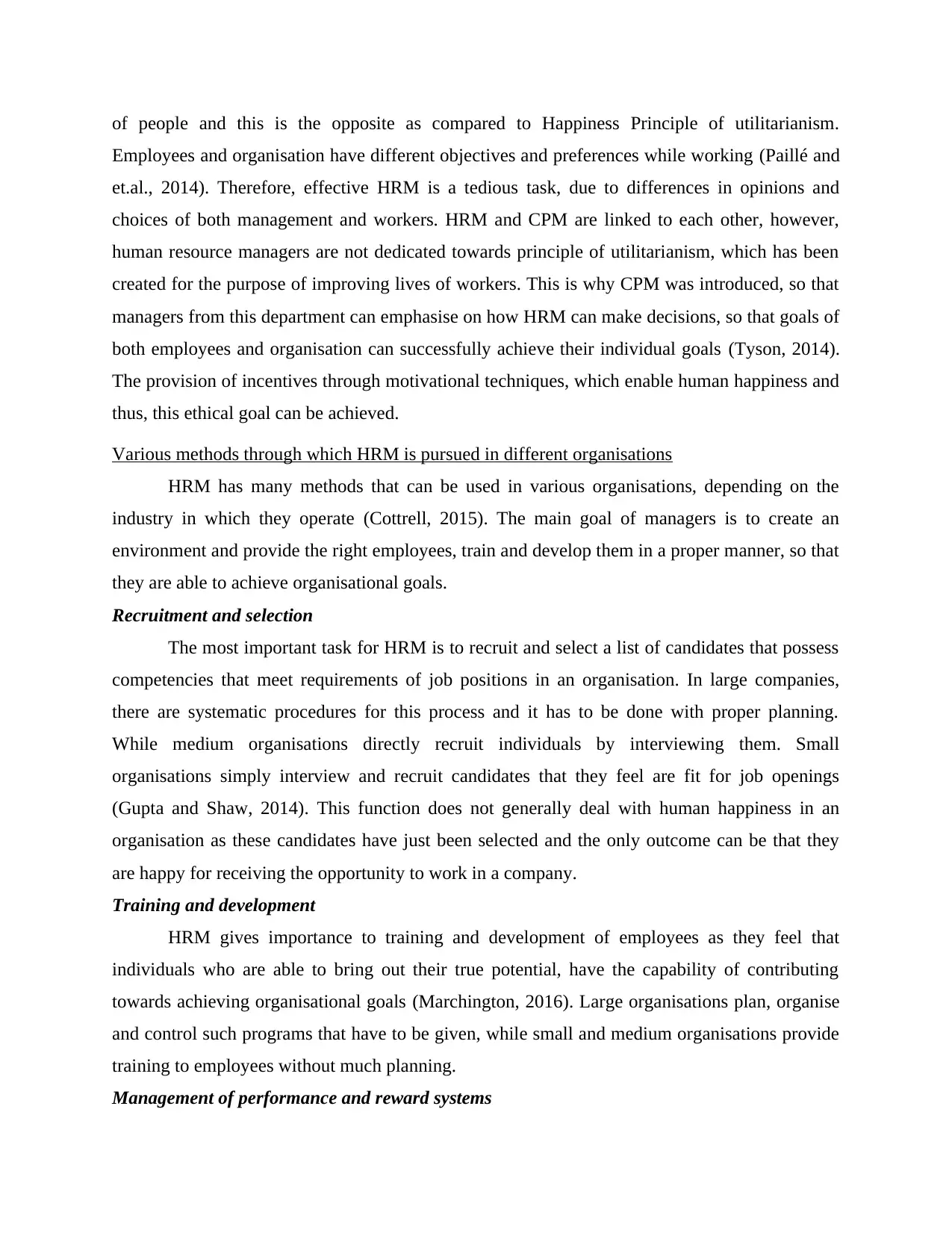
of people and this is the opposite as compared to Happiness Principle of utilitarianism.
Employees and organisation have different objectives and preferences while working (Paillé and
et.al., 2014). Therefore, effective HRM is a tedious task, due to differences in opinions and
choices of both management and workers. HRM and CPM are linked to each other, however,
human resource managers are not dedicated towards principle of utilitarianism, which has been
created for the purpose of improving lives of workers. This is why CPM was introduced, so that
managers from this department can emphasise on how HRM can make decisions, so that goals of
both employees and organisation can successfully achieve their individual goals (Tyson, 2014).
The provision of incentives through motivational techniques, which enable human happiness and
thus, this ethical goal can be achieved.
Various methods through which HRM is pursued in different organisations
HRM has many methods that can be used in various organisations, depending on the
industry in which they operate (Cottrell, 2015). The main goal of managers is to create an
environment and provide the right employees, train and develop them in a proper manner, so that
they are able to achieve organisational goals.
Recruitment and selection
The most important task for HRM is to recruit and select a list of candidates that possess
competencies that meet requirements of job positions in an organisation. In large companies,
there are systematic procedures for this process and it has to be done with proper planning.
While medium organisations directly recruit individuals by interviewing them. Small
organisations simply interview and recruit candidates that they feel are fit for job openings
(Gupta and Shaw, 2014). This function does not generally deal with human happiness in an
organisation as these candidates have just been selected and the only outcome can be that they
are happy for receiving the opportunity to work in a company.
Training and development
HRM gives importance to training and development of employees as they feel that
individuals who are able to bring out their true potential, have the capability of contributing
towards achieving organisational goals (Marchington, 2016). Large organisations plan, organise
and control such programs that have to be given, while small and medium organisations provide
training to employees without much planning.
Management of performance and reward systems
Employees and organisation have different objectives and preferences while working (Paillé and
et.al., 2014). Therefore, effective HRM is a tedious task, due to differences in opinions and
choices of both management and workers. HRM and CPM are linked to each other, however,
human resource managers are not dedicated towards principle of utilitarianism, which has been
created for the purpose of improving lives of workers. This is why CPM was introduced, so that
managers from this department can emphasise on how HRM can make decisions, so that goals of
both employees and organisation can successfully achieve their individual goals (Tyson, 2014).
The provision of incentives through motivational techniques, which enable human happiness and
thus, this ethical goal can be achieved.
Various methods through which HRM is pursued in different organisations
HRM has many methods that can be used in various organisations, depending on the
industry in which they operate (Cottrell, 2015). The main goal of managers is to create an
environment and provide the right employees, train and develop them in a proper manner, so that
they are able to achieve organisational goals.
Recruitment and selection
The most important task for HRM is to recruit and select a list of candidates that possess
competencies that meet requirements of job positions in an organisation. In large companies,
there are systematic procedures for this process and it has to be done with proper planning.
While medium organisations directly recruit individuals by interviewing them. Small
organisations simply interview and recruit candidates that they feel are fit for job openings
(Gupta and Shaw, 2014). This function does not generally deal with human happiness in an
organisation as these candidates have just been selected and the only outcome can be that they
are happy for receiving the opportunity to work in a company.
Training and development
HRM gives importance to training and development of employees as they feel that
individuals who are able to bring out their true potential, have the capability of contributing
towards achieving organisational goals (Marchington, 2016). Large organisations plan, organise
and control such programs that have to be given, while small and medium organisations provide
training to employees without much planning.
Management of performance and reward systems
Paraphrase This Document
Need a fresh take? Get an instant paraphrase of this document with our AI Paraphraser
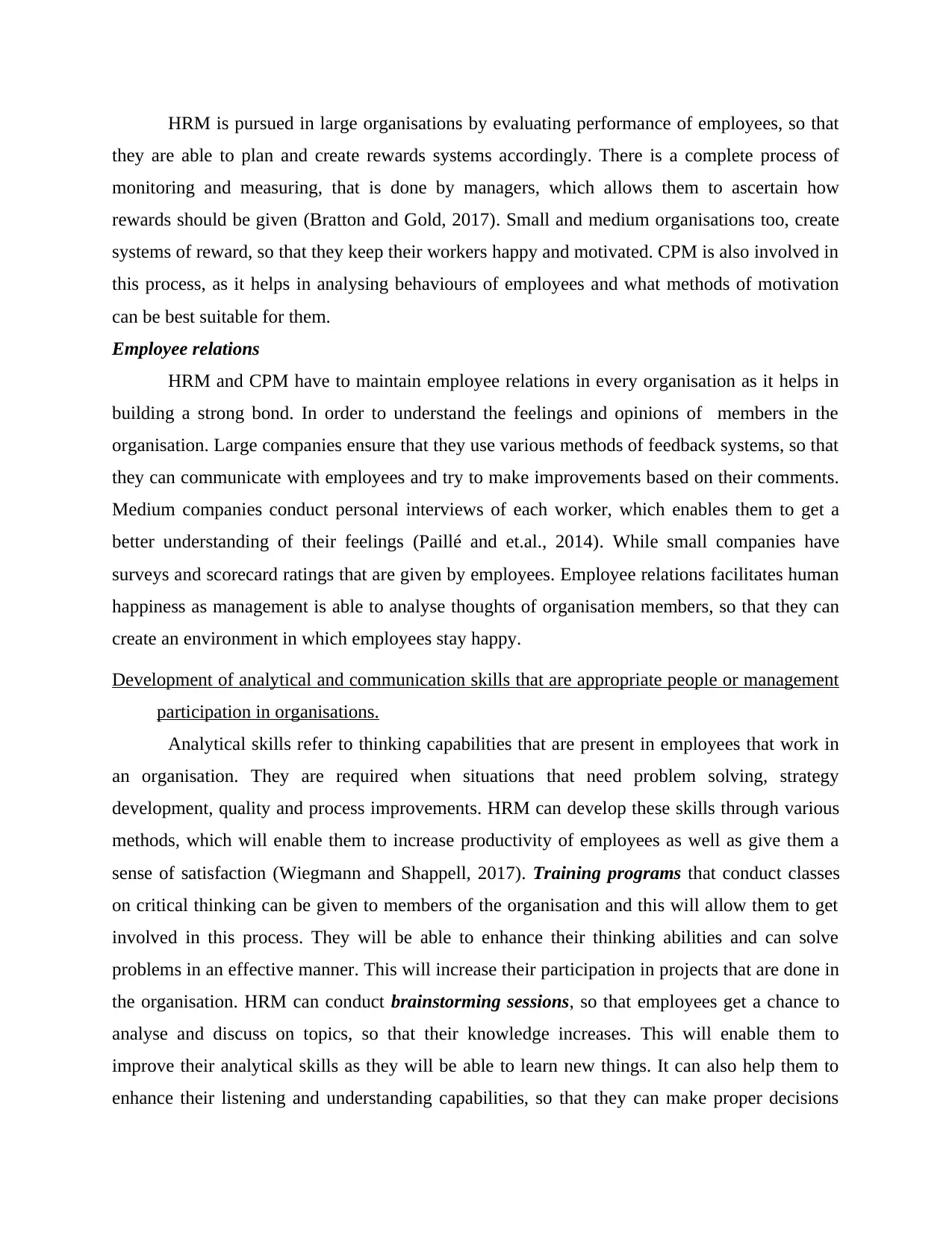
HRM is pursued in large organisations by evaluating performance of employees, so that
they are able to plan and create rewards systems accordingly. There is a complete process of
monitoring and measuring, that is done by managers, which allows them to ascertain how
rewards should be given (Bratton and Gold, 2017). Small and medium organisations too, create
systems of reward, so that they keep their workers happy and motivated. CPM is also involved in
this process, as it helps in analysing behaviours of employees and what methods of motivation
can be best suitable for them.
Employee relations
HRM and CPM have to maintain employee relations in every organisation as it helps in
building a strong bond. In order to understand the feelings and opinions of members in the
organisation. Large companies ensure that they use various methods of feedback systems, so that
they can communicate with employees and try to make improvements based on their comments.
Medium companies conduct personal interviews of each worker, which enables them to get a
better understanding of their feelings (Paillé and et.al., 2014). While small companies have
surveys and scorecard ratings that are given by employees. Employee relations facilitates human
happiness as management is able to analyse thoughts of organisation members, so that they can
create an environment in which employees stay happy.
Development of analytical and communication skills that are appropriate people or management
participation in organisations.
Analytical skills refer to thinking capabilities that are present in employees that work in
an organisation. They are required when situations that need problem solving, strategy
development, quality and process improvements. HRM can develop these skills through various
methods, which will enable them to increase productivity of employees as well as give them a
sense of satisfaction (Wiegmann and Shappell, 2017). Training programs that conduct classes
on critical thinking can be given to members of the organisation and this will allow them to get
involved in this process. They will be able to enhance their thinking abilities and can solve
problems in an effective manner. This will increase their participation in projects that are done in
the organisation. HRM can conduct brainstorming sessions, so that employees get a chance to
analyse and discuss on topics, so that their knowledge increases. This will enable them to
improve their analytical skills as they will be able to learn new things. It can also help them to
enhance their listening and understanding capabilities, so that they can make proper decisions
they are able to plan and create rewards systems accordingly. There is a complete process of
monitoring and measuring, that is done by managers, which allows them to ascertain how
rewards should be given (Bratton and Gold, 2017). Small and medium organisations too, create
systems of reward, so that they keep their workers happy and motivated. CPM is also involved in
this process, as it helps in analysing behaviours of employees and what methods of motivation
can be best suitable for them.
Employee relations
HRM and CPM have to maintain employee relations in every organisation as it helps in
building a strong bond. In order to understand the feelings and opinions of members in the
organisation. Large companies ensure that they use various methods of feedback systems, so that
they can communicate with employees and try to make improvements based on their comments.
Medium companies conduct personal interviews of each worker, which enables them to get a
better understanding of their feelings (Paillé and et.al., 2014). While small companies have
surveys and scorecard ratings that are given by employees. Employee relations facilitates human
happiness as management is able to analyse thoughts of organisation members, so that they can
create an environment in which employees stay happy.
Development of analytical and communication skills that are appropriate people or management
participation in organisations.
Analytical skills refer to thinking capabilities that are present in employees that work in
an organisation. They are required when situations that need problem solving, strategy
development, quality and process improvements. HRM can develop these skills through various
methods, which will enable them to increase productivity of employees as well as give them a
sense of satisfaction (Wiegmann and Shappell, 2017). Training programs that conduct classes
on critical thinking can be given to members of the organisation and this will allow them to get
involved in this process. They will be able to enhance their thinking abilities and can solve
problems in an effective manner. This will increase their participation in projects that are done in
the organisation. HRM can conduct brainstorming sessions, so that employees get a chance to
analyse and discuss on topics, so that their knowledge increases. This will enable them to
improve their analytical skills as they will be able to learn new things. It can also help them to
enhance their listening and understanding capabilities, so that they can make proper decisions
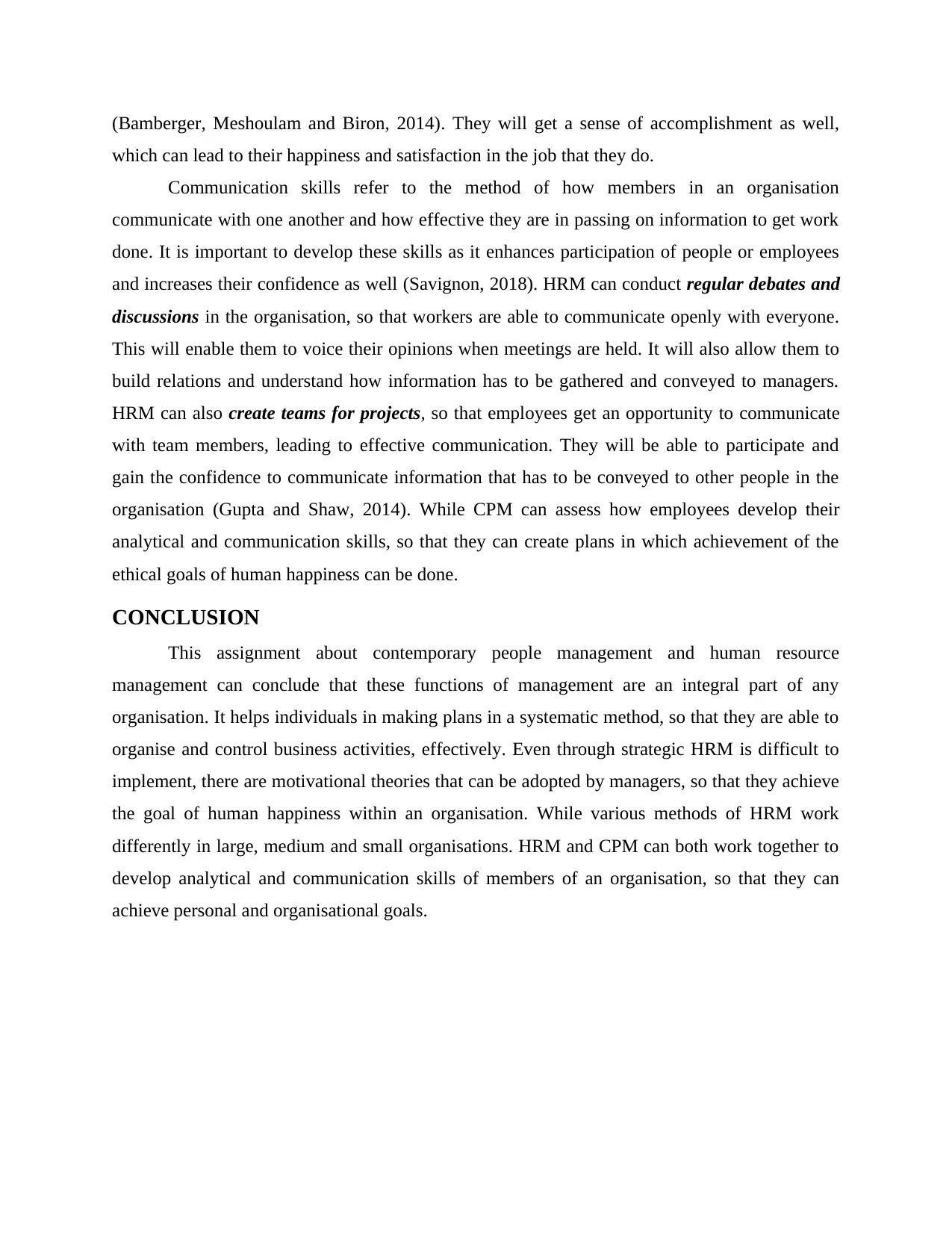
(Bamberger, Meshoulam and Biron, 2014). They will get a sense of accomplishment as well,
which can lead to their happiness and satisfaction in the job that they do.
Communication skills refer to the method of how members in an organisation
communicate with one another and how effective they are in passing on information to get work
done. It is important to develop these skills as it enhances participation of people or employees
and increases their confidence as well (Savignon, 2018). HRM can conduct regular debates and
discussions in the organisation, so that workers are able to communicate openly with everyone.
This will enable them to voice their opinions when meetings are held. It will also allow them to
build relations and understand how information has to be gathered and conveyed to managers.
HRM can also create teams for projects, so that employees get an opportunity to communicate
with team members, leading to effective communication. They will be able to participate and
gain the confidence to communicate information that has to be conveyed to other people in the
organisation (Gupta and Shaw, 2014). While CPM can assess how employees develop their
analytical and communication skills, so that they can create plans in which achievement of the
ethical goals of human happiness can be done.
CONCLUSION
This assignment about contemporary people management and human resource
management can conclude that these functions of management are an integral part of any
organisation. It helps individuals in making plans in a systematic method, so that they are able to
organise and control business activities, effectively. Even through strategic HRM is difficult to
implement, there are motivational theories that can be adopted by managers, so that they achieve
the goal of human happiness within an organisation. While various methods of HRM work
differently in large, medium and small organisations. HRM and CPM can both work together to
develop analytical and communication skills of members of an organisation, so that they can
achieve personal and organisational goals.
which can lead to their happiness and satisfaction in the job that they do.
Communication skills refer to the method of how members in an organisation
communicate with one another and how effective they are in passing on information to get work
done. It is important to develop these skills as it enhances participation of people or employees
and increases their confidence as well (Savignon, 2018). HRM can conduct regular debates and
discussions in the organisation, so that workers are able to communicate openly with everyone.
This will enable them to voice their opinions when meetings are held. It will also allow them to
build relations and understand how information has to be gathered and conveyed to managers.
HRM can also create teams for projects, so that employees get an opportunity to communicate
with team members, leading to effective communication. They will be able to participate and
gain the confidence to communicate information that has to be conveyed to other people in the
organisation (Gupta and Shaw, 2014). While CPM can assess how employees develop their
analytical and communication skills, so that they can create plans in which achievement of the
ethical goals of human happiness can be done.
CONCLUSION
This assignment about contemporary people management and human resource
management can conclude that these functions of management are an integral part of any
organisation. It helps individuals in making plans in a systematic method, so that they are able to
organise and control business activities, effectively. Even through strategic HRM is difficult to
implement, there are motivational theories that can be adopted by managers, so that they achieve
the goal of human happiness within an organisation. While various methods of HRM work
differently in large, medium and small organisations. HRM and CPM can both work together to
develop analytical and communication skills of members of an organisation, so that they can
achieve personal and organisational goals.
⊘ This is a preview!⊘
Do you want full access?
Subscribe today to unlock all pages.

Trusted by 1+ million students worldwide
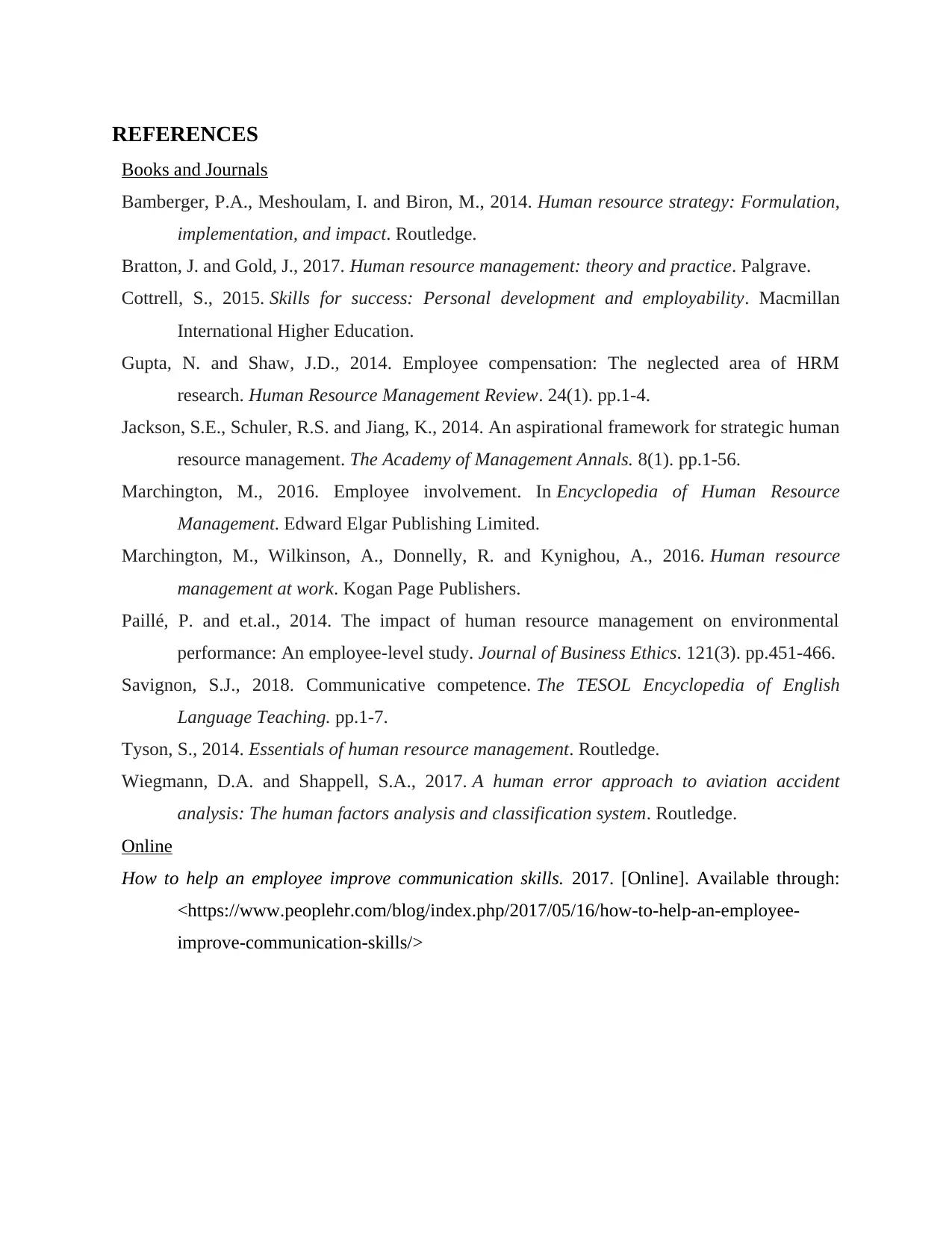
REFERENCES
Books and Journals
Bamberger, P.A., Meshoulam, I. and Biron, M., 2014. Human resource strategy: Formulation,
implementation, and impact. Routledge.
Bratton, J. and Gold, J., 2017. Human resource management: theory and practice. Palgrave.
Cottrell, S., 2015. Skills for success: Personal development and employability. Macmillan
International Higher Education.
Gupta, N. and Shaw, J.D., 2014. Employee compensation: The neglected area of HRM
research. Human Resource Management Review. 24(1). pp.1-4.
Jackson, S.E., Schuler, R.S. and Jiang, K., 2014. An aspirational framework for strategic human
resource management. The Academy of Management Annals. 8(1). pp.1-56.
Marchington, M., 2016. Employee involvement. In Encyclopedia of Human Resource
Management. Edward Elgar Publishing Limited.
Marchington, M., Wilkinson, A., Donnelly, R. and Kynighou, A., 2016. Human resource
management at work. Kogan Page Publishers.
Paillé, P. and et.al., 2014. The impact of human resource management on environmental
performance: An employee-level study. Journal of Business Ethics. 121(3). pp.451-466.
Savignon, S.J., 2018. Communicative competence. The TESOL Encyclopedia of English
Language Teaching. pp.1-7.
Tyson, S., 2014. Essentials of human resource management. Routledge.
Wiegmann, D.A. and Shappell, S.A., 2017. A human error approach to aviation accident
analysis: The human factors analysis and classification system. Routledge.
Online
How to help an employee improve communication skills. 2017. [Online]. Available through:
<https://www.peoplehr.com/blog/index.php/2017/05/16/how-to-help-an-employee-
improve-communication-skills/>
Books and Journals
Bamberger, P.A., Meshoulam, I. and Biron, M., 2014. Human resource strategy: Formulation,
implementation, and impact. Routledge.
Bratton, J. and Gold, J., 2017. Human resource management: theory and practice. Palgrave.
Cottrell, S., 2015. Skills for success: Personal development and employability. Macmillan
International Higher Education.
Gupta, N. and Shaw, J.D., 2014. Employee compensation: The neglected area of HRM
research. Human Resource Management Review. 24(1). pp.1-4.
Jackson, S.E., Schuler, R.S. and Jiang, K., 2014. An aspirational framework for strategic human
resource management. The Academy of Management Annals. 8(1). pp.1-56.
Marchington, M., 2016. Employee involvement. In Encyclopedia of Human Resource
Management. Edward Elgar Publishing Limited.
Marchington, M., Wilkinson, A., Donnelly, R. and Kynighou, A., 2016. Human resource
management at work. Kogan Page Publishers.
Paillé, P. and et.al., 2014. The impact of human resource management on environmental
performance: An employee-level study. Journal of Business Ethics. 121(3). pp.451-466.
Savignon, S.J., 2018. Communicative competence. The TESOL Encyclopedia of English
Language Teaching. pp.1-7.
Tyson, S., 2014. Essentials of human resource management. Routledge.
Wiegmann, D.A. and Shappell, S.A., 2017. A human error approach to aviation accident
analysis: The human factors analysis and classification system. Routledge.
Online
How to help an employee improve communication skills. 2017. [Online]. Available through:
<https://www.peoplehr.com/blog/index.php/2017/05/16/how-to-help-an-employee-
improve-communication-skills/>
1 out of 7
Related Documents
Your All-in-One AI-Powered Toolkit for Academic Success.
+13062052269
info@desklib.com
Available 24*7 on WhatsApp / Email
![[object Object]](/_next/static/media/star-bottom.7253800d.svg)
Unlock your academic potential
Copyright © 2020–2025 A2Z Services. All Rights Reserved. Developed and managed by ZUCOL.





